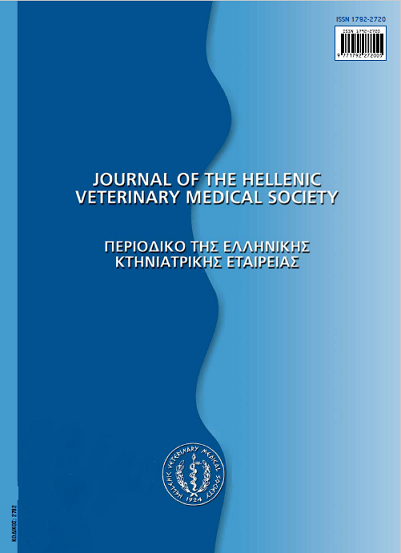Is there any place for "second-line" medication in the treatment of canine leishmaniosis? The aminosidine paradigm
Abstract
Leishmaniosis is one of the most common diseases of dogs in the Mediterranean countries with zoonotic potential. Based on recent publications, the drugs currently in use for the treatment of this disease have been grouped into "first-line" (meglumine antimoniate, allopurinol, combination of the former, amphotericin B) and "second-line" (aminosidine, pentamidine, metronidazole in combination with enrofloxacin or with spiramycin, miltefosine, ketokonazole). For an objective comparison of the usefulness of these antileishmanial medications, various factors, such as route, dose and frequency of administration, clinical efficacy, toxicity, achievement of parasitological cure or change of the immunological response of the patient, and infectiousness of treated dogs to sandflies, should be taken into consideration. Clearly, if all remaining factors are constant, orally administered agents would be preferable, because no hospitalization is needed and local reactions at the injection sites are at best avoided. Dose and frequency of administration should be defined by performing drug pharmacokinetic and pharmacodynamic studies, in order to reduce toxicity, increase efficacy and avoid development of resistant parasite strains. Ideally, clinical efficacy and safety should be assessed in staged clinical trials, starting with toxicological studies, followed by observational trials, and finally by blinded-controlled trials. Unfortunatelly, such rigorous testing has not been performed for many antileishmanial medications applied to the dog. Also, dosing schedules that are considered sub-optimal from a pharmacological standpoint have been employed for some of them, most likely resulting in erroneous conclusions. Aminosidine is perhaps the most typical example, since it has been tested at a wrong dose (5mg/kg B.W.) and frequency of administration (every 12 hours) in all controlled trials so far conducted. Nowadays, it is clear that parasitological cure cannot be achieved in the majority of treated dogs, irrespectively of the therapeutic protocol employed. Furthermore, even if it had been feasible, the total elimination of the parasite would have been meaningless for dogs residing in the endemic areas of the disease. For these reasons, one of the most important ,but largely unexplored goals of antileishmanial treatment is to change the immunological response of the patient, thus rendering previously susceptible dogs resistant to disease and its relapses. Although the infectivity of treated dogs to sandflies is reduced, it is not usually eliminated. From an epidemiological point of view this may be of minor importance, given the high prevalence of the infection among the canine population. However, from a public health perspective, transmission of potentially drug-resistant strains of the parasite is a major consideration. Strategiesto avoid or delay their occurrence include optimal dosing and treatment duration, use of different medications in relapsing cases, combination of drugs with different mode of action and, when possible, preference for medications that are not currently in use for the treatment of human visceral leishmaniasis. Aminosidine, although injectable and contraindicated in dogs with renal failure, offers some advantages, such as the low cost, commercial availability in Greece, once daily administration and satisfactory efficacy and safety when used at the optimal dose. Also, it is not currently employed for the treatment of human disease, at least in the Mediterranean countries. For all these reasons, blinded-controlled trials are urgently needed to definitely prove if aminosidine can be really considered as a "first-line" drug for the treatment of canine leishmaniosis.
Article Details
- Zitationsvorschlag
-
SARIDOMICHELAKIS (Μ. Ν. ΣΑΡΙΔΟΜΙΧΕΛΑΚΗΣ) N. M., ATHANASIOU (Λ. ΑΘΑΝΑΣΙΟΥ) V. L., & KASABALIS (Δ. ΚΑΣΑΜΠΑΛΗΣ) D. (2017). Is there any place for "second-line" medication in the treatment of canine leishmaniosis? The aminosidine paradigm. Journal of the Hellenic Veterinary Medical Society, 59(3), 239–246. https://doi.org/10.12681/jhvms.14961
- Ausgabe
- Bd. 59 Nr. 3 (2008)
- Rubrik
- Review Articles
Authors who publish with this journal agree to the following terms:
· Authors retain copyright and grant the journal right of first publication with the work simultaneously licensed under a Creative Commons Attribution Non-Commercial License that allows others to share the work with an acknowledgement of the work's authorship and initial publication in this journal.
· Authors are able to enter into separate, additional contractual arrangements for the non-exclusive distribution of the journal's published version of the work (e.g. post it to an institutional repository or publish it in a book), with an acknowledgement of its initial publication in this journal.
· Authors are permitted and encouraged to post their work online (preferably in institutional repositories or on their website) prior to and during the submission process, as it can lead to productive exchanges, as well as earlier and greater citation of published work.









